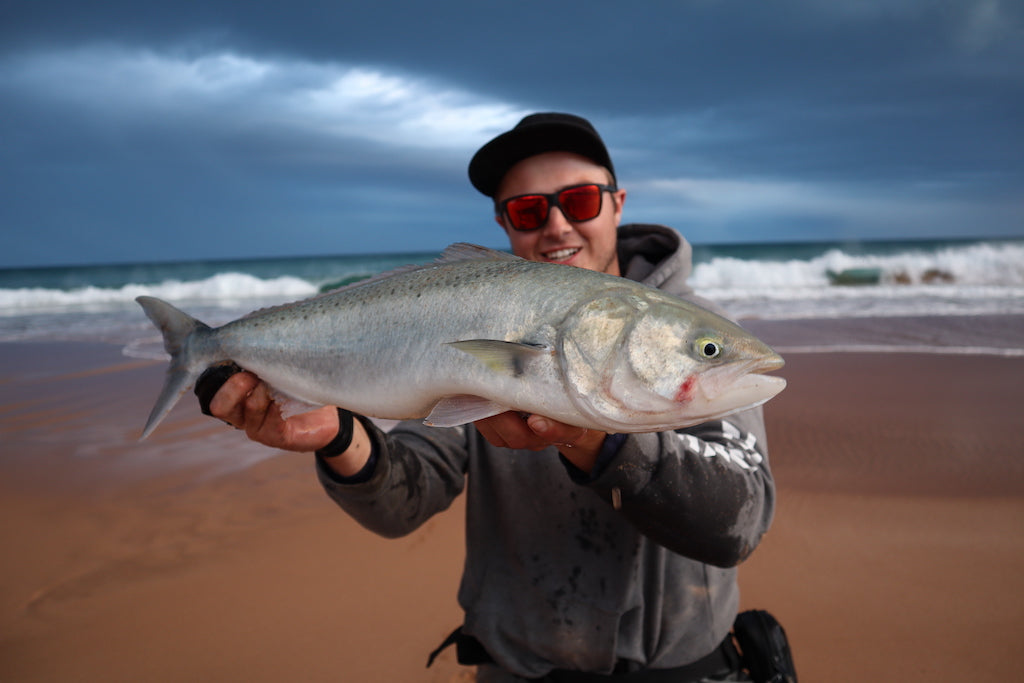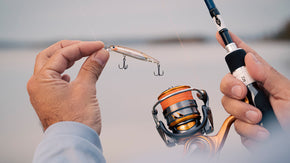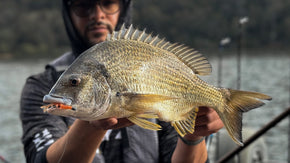Posted 29th July 2022
How to Catch Australian Salmon


By Joshua Davey
Winter along the south coast can be a difficult period when it comes to angling. For many it typically means the end of the boating and fishing season, with people opting to hang up their tackle and tuck their boats into bed in favour of waiting for next summer. I have certainly been guilty myself, setting that early fishing alarm on a weekend only to be greeted by howling winds and sideways rain. It doesn’t exactly inspire confidence, so sometimes that warm bed can be very enticing.

Nevertheless! With winter, comes opportunity to anglers keen enough to get out there and seek it. One of those options for me, is the humble Australian salmon. As a bit of background, Australian salmon aren’t actually a species of salmon at all (misleading, I know). Instead they belong to the family of perch, and aren’t exactly renowned for their eating qualities. But for what they lack in taste, they certainly make up for in sporting ability as these light tackle scrappers can seriously pack a punch, with fiery runs and some spectacular aerial displays.
Pair this with their accessibility to all recreational anglers over winter and we have a recipe for some of the best shore-based angling on offer. As I briefly mentioned, Australian salmon (hereafter Salmon) are a fantastic option forshore-based anglers. They are often found in large schools and are a regular occurrence along most surf beaches in southern Australia.
Salmon can be targeted using a variety of baits, but my preferred option is to throw small metal lures. This technique allows me to cover a greater area and I would argue that it also allows me to catch more fish when they are on the chew as it minimises the time between casts (i.e. negates the need for rebaiting hooks). Additionally, surf fishing tackle has advanced in leaps and bounds over recent years which I feel is rarely touched on in fishing media.
Gone are the days of lugging around a heavy, cumbersome 15ft one piece cane rod, with a reel that weighs as much as a brick and mono the thickness of your finger. Instead, todays tackle is so refined that I can spend consecutive days casting with minimal to no fatigue. I recently picked up a new outfit for this winters “Salmon season”, which consists of a 23 Seajigger 1002ML or a previous generation Seajigger 305ML paired with a 5000HD Revelry spooled with 20lb J-Braid Grand and a 20lb J-Thread FC leader. I must say it is an absolute dream to fish with.
The Seajigger's action is incredibly versatile (ill touch on this more later), but the Monocoque and Magseal features of the Revelry make it a brilliant choice to stand up to the harsh conditions the surf can present. Ideally a light weight graphite rod between 9 and 11ft is perfect for this style of fishing, provided it can cast a 40g lure (read the rod specs on the Daiwa website to find the cast weight). The Seajigger has a cast weight of 20-60g, but I find that its sweet spot is between 40 and 50g for distance, and boy can it cast! Ideally match the lure weights to the rod of your choice, but more often than not I find myself falling back to 40g as an all-rounder. I like to break down metal lures into two distinct categories, ones that prioritise distance,and the others that prioritise action. Unfortunately it seems that the lures which have amazing actions. In the water don’t cast all too well and vice versa, but luckily for us, Salmon will eat just about anything you throw at them. Distance is usually the limiting factor, so I often prefer using lures that cast further at the detriment of their action.

So, after that lengthy rundown you have gone and purchased all the gear you need to target Salmon, and have rolled up to your local surf beach. Now what? I often spend a good 5 – 10 minutes, ideally from a high vantage point to look at the water and scope the beach. Now what you really hope to see is a big brown/black mass moving through the water, I will attach an image to this article to show what I mean. These are big schools of Salmon, which when in casting range create some of the best fishing opportunities you can have from the beach and really get your heart pumping.
The feeling of coming across one of these schools and cranking your lure through them, only to have it hit so hard it nearly tears your arms out their sockets is honestly one of the most exciting forms of fishing I have come across. But as it often goes in fishing, it isn’t always like this. If the visual signs of a school aren’t there however, do not be disheartened as it doesn’t mean that they aren’t there.
My next port of call when scoping the beach is to take note of where the main gutters are, ideally the rips that run out to the open ocean. This is where I will focus my attention, with the technique more often than not being as simple as casting out and winding back in, rinse, repeat. Changing up the retrieve speed can make a difference though, and do not be afraid to really burn that lure in almost as fast as you can. Sometimes this can trigger a reaction out of the Salmon to chase the lure down and hit it with gusto.
Recently I have been experimenting with the technique of “Shore Jigging”, which involves casting the metal out and hopping it back to shore, allowing the lure to almost make contact with the bottom between hops. This has been incredibly successful, often triggering bites when the fish are shut down and really where that parabolic action of a rod like the Seajigger comes into its own. So as I mentioned, mix up your retrieves, there is no hard and fast rule when it comes to working your lure for salmon.
Hopefully this has inspired some of you to get out this winter in chase of the mighty Australian salmon, see you on the beach soon.
















